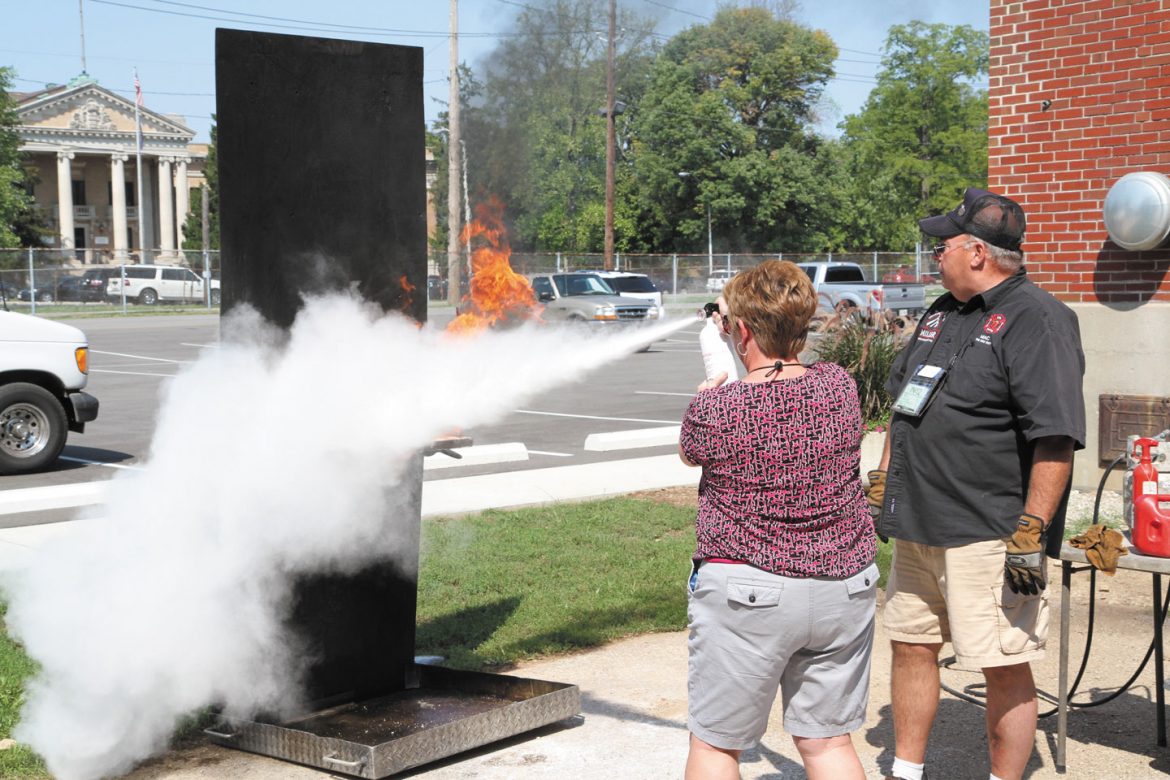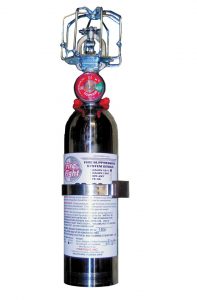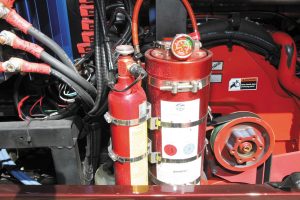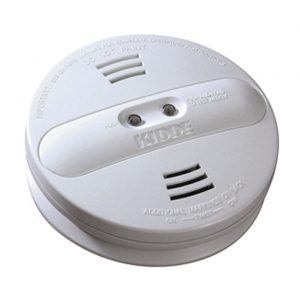Making a plan and having the proper equipment can help to avert disaster.
By Mark Quasius, F333630
May 2019
An RV fire can quickly lead to devastating damage; injury; or, in the worst-case scenario, loss of life. Therefore, it’s important that RVers implement a fire-safety plan that includes knowing how to exit the RV; having a sufficient number of fire extinguishers of an adequate type and size; installing devices that warn of dangerous levels of smoke and propane (as well as carbon monoxide); and possibly installing an automatic extinguisher for a refrigerator or engine compartment.
Escape Options
When a fire breaks out, your first decision is whether to fight it or flee. Because RV fires can quickly become unmanageable, fast action is crucial. Some RV owners place important items in a pouch that they keep near the door, so it’s easy to grab on the way out.
The door, of course, may not be accessible. Emergency exit windows are mandated by law, but crawling through one may be difficult. Some windows pop out, but many can slam shut on you, so you may want to keep handy a pole of some sort to hold the window open. You also might have to deal with a significant drop to the ground, unless a picnic table or bench is below the window. Rope ladders can be purchased, but you must be able to find and deploy the ladder quickly to avoid being overcome by smoke inhalation.
Rather than an emergency exit window, some Type A motorhomes have an emergency exit door. Whatever your options, it’s important to have an escape plan and practice it with your travelers.
Fire Classifications
A fire needs three elements to ignite: fuel (such as wood, carpet, gasoline, diesel fuel, and propane); oxygen; and heat. Fire extinguishers put out fires by removing one or more of these elements.
Although RVs come equipped with fire extinguishers, they often meet only the minimum standards provided by the National Fire Protection Association. Many models are undersized and fall short of what’s needed to put out anything but a very small fire.
Before we examine the types of fire extinguishers, it’s important to understand how the fires most likely to occur in RVs are classified.
Class A fires involve solid combustible fuels (other than metals), such as wood, paper, cloth, and plastics. These are the easiest fires to put out. Water works well. Ideally, an element (such as soap) is added to the water to break the surface tension and separate the fuel from its oxygen.
Class B fires involve flammable liquids, such as gasoline, oil, grease, diesel fuel, and alcohol. Water won’t extinguish such fires, because the liquid fuel floats on the water’s surface and spreads to other areas.
Class C electrical fires are caused by energized circuits. If a circuit is live, consider the fire a Class C blaze. The wire itself doesn’t burn, but the insulation and anything surrounding it does. Using water on Class C fires can create an electrical shock hazard. Once the circuit is de-energized, the blaze can be treated as a Class A fire.
Fire Extinguisher Ratings
Fire extinguishers tested by UL, a global safety certification company, are labeled with a rating that indicates the size and types of fires the extinguishers can put out. Each letter stands for a fire classification — that is, Class A, B, or C.
The number preceding the letter A is a water equivalency rating, with each A equal to 1.25 gallons of water. For example, a 2A extinguisher is rated as effective as using 2.5 gallons of water on Class A fires; a 3A extinguisher is as effective as using 3.75 gallons of water, etc.
The number rating for Class B and C extinguishers represents the square footage that the extinguisher is designed to handle. So, a 10B:C extinguisher can handle Class B or C fires up to 10 square feet. It’s common to combine ratings on a single extinguisher, such as 2A:10B:C.
Fire Extinguisher Types
Using the wrong type of fire extinguisher on certain fires can be life threatening. Following is a brief description of the types of extinguishers and the fire-fighting agents they employ:
Air pressurized water (APW):
Extinguishes Class A fires.
APWs are large tanks filled about two-thirds with water and then pressurized with compressed air. Pulling the trigger shoots water from the hose and nozzle.
Carbon Dioxide (CO₂):
Extinguishes Class B and C fires.
The extinguishers are filled with highly pressurized carbon dioxide, which exits through a hard plastic horn and displaces oxygen from a fire, suffocating it. Because the CO₂ is cold as it exits the extinguishers, it also cools the fire. CO₂ generally is not effective on Class A fires, because it may scatter burning particles and may not displace enough oxygen to smother the blaze and prevent it from reigniting.
Dry Chemical:
Extinguishes Class A, B, and C fires.
These are the most popular extinguishers among consumers. The dry chemical is a fine powder that is pressurized with nitrogen. The dry chemical interrupts the chemical reaction that occurs among elements of a fire (fuel, oxygen, and heat).
Many RVs come equipped with a 3.9-pound dry-chemical fire extinguisher rated at 1A:10B:C. As a fire-fighting tool, it’s undersized, and therefore its usefulness is extremely limited. If you choose a dry-chemical extinguisher, I recommend a larger one, such as a 9-pound 3A:40B:C.
One downside of dry-chemical extinguishers is that they leave a mess. The powder extinguishes electrical fires, but it is corrosive to electrical circuits, so once it’s used, electrical components may need to be replaced. In addition, inhaling or coming into contact with certain types of dry-chemical powders can cause irritation to the nose, throat, and lungs, as well as dizziness and headaches.
Over time, the dry chemical tends to settle in the cylinder and become packed down. Therefore, every six months, turn the extinguisher upside down and whack the base with a rubber mallet so that the powder remains loose enough to be expelled. Most of these extinguishers come with a pressure gauge that should be checked regularly. If the gauge indicates a recharge is needed, it may be possible to refill the extinguisher, but usually inexpensive throwaway models simply should be replaced.
Clean-Agent Gas:
Extinguishes Class A, B, and C fires.
These extinguishers use an inert gas to interrupt the chemical reaction in a fire and/or remove heat. Halon has been banned in many areas, because it destroys ozone, but environmentally acceptable clean-agent gas alternatives are available. They leave no mess and don’t conduct electricity.
Two types of clean agents exist, flooding and streaming. Flooding types are more gaseous, and often are used in enclosed, unoccupied areas where the gas can’t escape, such as computer rooms and engine compartments of boats. When such extinguishers are used in an open or fan-ventilated area, the gas can disperse, allowing the fire to flare up again.
Streaming clean agents, such as Halotron 1, are discharged from a portable extinguisher as a liquid and then turn into a gas. This allows the user to stand back from a fire. Although Halotron 1 is approved for use in occupied spaces, inhaling it should be avoided. It should be used outdoors or in an enclosed area that can be adequately ventilated after use. A Halotron 1 fire extinguisher is capable of putting out a Class A fire, but it is not as effective in doing so as a dry-chemical extinguisher.
Aqueous Film-Forming Foam (AFFF):
Extinguishes Class A and B fires.
AFFF is a soap-like foam agent that is mixed with water. The foam blankets a fire, suffocates it, cools it, and prevents reignition. Technically, AFFF can conduct electricity, but in a fire involving high-voltage electrical wiring, the conductors generally short out and trip the circuit breaker, which de-energizes the circuit and removes the fire from the Class C category.
High-Expansion Air-Compressed Foam:
Extinguishes Class A and B fires.
These extinguishers employ a mix of denatured water and a foam. They are more effective than AFFF extinguishers. The foam provides a viscous, nonflammable layer to block air from the fuel; the foam also renders hydrocarbons such as gasoline or oil inert so they cannot reignite. The foam clings to vertical surfaces and produces no toxic gases.
Fire Fight Products sells handheld 16-ounce extinguishers, the SS20 ($30 plus shipping), which can be used on small fires, such as on a kitchen stovetop. The best practice is to keep multiple units handy — one in the bedroom, one up front by the entry door, one in an outside storage compartment, and one in the towed or towing vehicle.
Fire Fight’s 6-liter SS450 handheld extinguisher ($245 plus shipping) provides significantly more fire-fighting capacity. It comes with a spare can of foam, enough to refill the extinguisher twice. The refill procedure: Add distilled water and 8 ounces of foam to the extinguisher, and then charge it with compressed gas.
Jim Bounds, CEO of Fire Fight Products, said the company’s fire extinguishers are supplemental fire safety products. Individual components of the fire extinguishers have been tested by UL, but the overall units have not, and therefore they do not carry a UL rating.
Automatic Extinguishers
Many RVs have absorption-style refrigerators. They contain an ammonia-based mixture that can release explosive hydrogen gas should the cooling unit rupture and leak. The gas can be ignited quickly by a heat source.
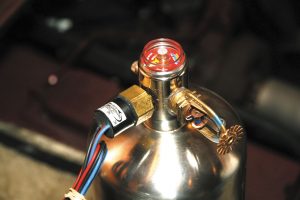
It’s advisable for automatic fire extinguisher systems to have a remote alarm that senses pressure loss.
To control that kind of fire, compact automatic extinguishers that use a clean-agent gas can be installed in an enclosed compartment behind the refrigerator. Fire Fight’s SS30 was designed specifically for this type of application, and it works equally well in generator compartments. Its HFC227 gas can be dispensed through the standard sprinkler-style head or through a remote head attached to the cylinder via a 6-foot-long, stainless-steel braided hose. The cost of the SS30 series is about $250.
An automatic extinguisher also can be a good choice for the engine compartment of a motorhome. A leak in a gas-powered coach can result in fuel coming in contact with hot engine parts or electrical components. And in a diesel-powered motorhome, the engine’s turbochargers can reach extreme temperatures, especially when working hard or climbing grades. If a hydraulic fan line or fuel line becomes loose or fails, flammable fluid can spray on the engine bay and ignite.
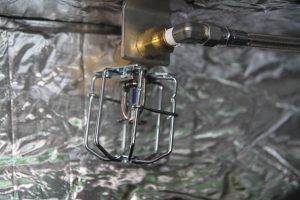
High-expansion air-compressed foam is dispensed from this remote sprinkler head, which is attached to a Fire Fight Products cylinder via a stainless-steel braided hose.
One option for engine compartments is an automatic extinguisher using high-expansion air-compressed foam, which coats the fire and reduces the temperature. Fire Fight Products offers such systems in three cylinder sizes: SS100 (2 liters of foam); SS200 (3 liters); and SS300 (4 liters). The head can be mounted directly on the top of the cylinder or can be mounted remotely on stainless-steel braided hoses. The 4-liter system is available with two remote heads to cover larger areas. When the engine is running, a fire may reflash. So, a larger cylinder, with a longer run time, can allow you more time to get off the road and shut down the engine.
Proteng is another company with an automatic fire suppression system. It is available in two versions — standard and heavy-duty. Each is intended to be used in enclosed areas, such as diesel or gas engine compartments, battery compartments, and other electrical areas. The system consists of a polyamide (synthetic polymer) tube that is filled with the clean agent FM-200, which is nontoxic and noncorrosive. When the standard system is exposed to direct flame or temperatures that exceed 158 degrees Fahrenheit, the tube ruptures, releasing the FM-200. The heavy-duty system uses a thicker polyamide tube, which ruptures when exposed to flame or temperatures exceeding 194 degrees Fahrenheit. The length of tube required depends on the size of the area needing protection.
Fogmaker International AB also offers an automatic fire suppression system for engine compartments. According to the company website, the system dispenses a high-pressure mix of water and aqueous film-forming foam as a dense fog that can decrease temperatures by 700 degrees Celsius (1,292 degrees Fahrenheit) within 10 seconds. The dense water vapor displaces oxygen, and the AFFF prevents reignition of hydrocarbon vapors. A sensor connects to a warning display on the cockpit instrument panel.
The cost of automatic systems ranges from about $160 to $900.
When a fire in the engine compartment of a diesel pusher deploys an automatic extinguisher, the fire may go unnoticed by the driver for a considerable time. In fact, once the extinguisher is empty, the fire may reignite. Therefore, I recommend that an automatic fire suppression system have a remote alarm that senses pressure loss in the extinguisher. With an early warning of a fire, the driver can safely pull off the road, analyze the fire, and attack it with a handheld extinguisher, if necessary.
Most any type of alarm can be used. You can buy a professional alarm or make something as simple as a 12-volt buzzer and flashing light on the dash. Fire Fight offers an optional pressure switch, but you must specify this when ordering a system, because it’s not shown on the company’s website.
Smoke Alarms
An effective warning system can be the difference between saving an RV or making a speedy exit while it burns to the ground.
The longer an RV is, the more time it takes for smoke to travel from one end to the other, so it’s important to install multiple smoke alarms. They should be mounted on the ceiling or on a sidewall close to the ceiling. Place one in the rear and another in the front of the RV. To avoid false alerts, don’t install one in the cooking area.
Smoke alarms may utilize ionization or photoelectric sensing technologies, or both. Ionization alarms are more responsive to flaming fires. Photoelectric alarms are more sensitive to smoldering fires, such as when electrical wiring is shorted and its insulation begins to burn slowly with smoke but no flame. In that case, you can shut down the electrical circuit to prevent a full-blown fire.
Manufacturers such as Kidde and First Alert make dual-sensor smoke alarms that incorporate both types of sensors in one unit.
Other Detectors
If a leak develops in a propane line or if a propane appliance fails, the highly flammable gas can build up inside an RV. Propane is heavier than air, so it settles to the floor where a pilot light or spark can ignite it and start a major fire. That’s why propane alarms generally are mounted very low on an interior wall, next to the floor. Avoid using aerosols such as hair spray and various cleaning agents near a propane alarm, because they can ruin it. Test the alarm regularly.
A carbon monoxide (CO) alarm won’t alert you to fire, but the colorless, odorless gas is just as deadly, so we’re including it here. CO, a byproduct of combustion, can come from a furnace with a cracked heat exchanger, or from a vehicle exhaust, or even the exhaust from a nearby camper’s generator. The lighter-than-air gas rises, so a CO alarm should be installed up high.
Some RVs come equipped with a combination propane/CO alarm, which is generally located beneath the refrigerator. This is the perfect location for detecting propane but not for CO. If you have such a setup, I suggest adding a ceiling-mounted CO alarm.
Some smoke alarms feature a digital LCD display that shows how much CO has accumulated. As little as 250 parts per million over an eight-hour period can be fatal. A good alarm will add up the accumulative amounts to protect you from a slow CO buildup, but less expensive models may sound an alert only if a large amount of CO is present at one time. Keep in mind that alarms for CO and smoke should not be mounted beneath a cabinet. They should be at the highest point in the RV.
Summary
When dealing with a fire, it’s important to stay calm, and you’ll have a better chance of that if you’ve rehearsed what to do in any given situation. Discuss and practice how to deal with a particular fire and whether to fight it or just safely exit the RV. Know your escape route and method so you don’t have to figure it out in an emergency.
Be sure to outfit your RV with adequate fire extinguishers in multiple locations to cover your needs. Install smoke, propane, and carbon monoxide detectors in places where they will be most effective.
Knowledge is power. Attend a fire and life safety seminar at an FMCA convention. You’ll gain immeasurable knowledge to help stay safe in your RV travels.
Equipment Suppliers
Fire Fight Products
(321) 299-5707
www.firefightproducts.com
First Alert
(800) 323-9005
www.firstalert.com
Fogmaker North America
(610) 265-3610
http://www.usscgroup.com/fogmaker-fire-suppression/
Kidde
(800) 880-6788
www.kidde.com
Proteng
(561) 776-8364
https://proteng.com
Fire Extinguisher Recall
The recall of millions of Kidde fire extinguishers has been widely reported, including in this magazine, but it bears repeating. The recall involves models of Kidde extinguishers with plastic handles that were manufactured from January 1, 1973, to August 15, 2017. The fire extinguishers can become clogged or require excessive force to discharge and can fail during a fire emergency. To determine whether you have an affected model and to request a free replacement fire extinguisher, contact Kidde at (855) 271-0773 or visit www.kidde.com and click on the “Product Safety Recalls” box.

